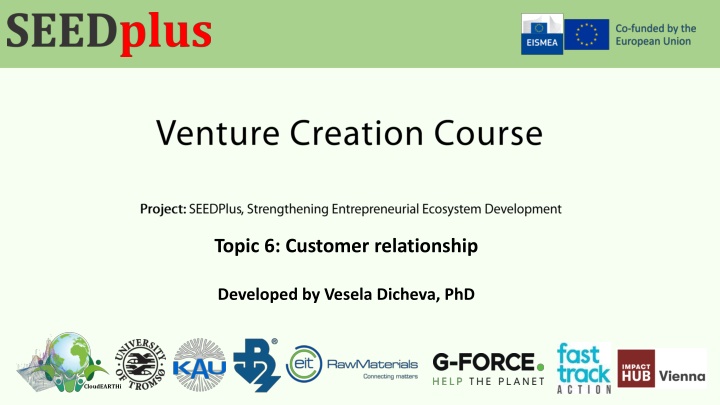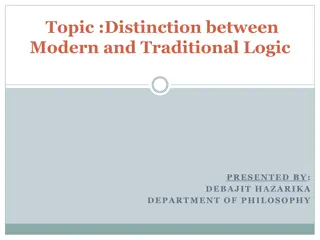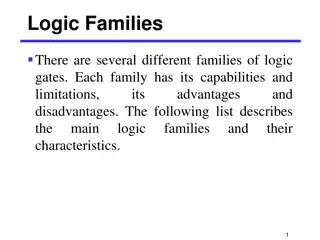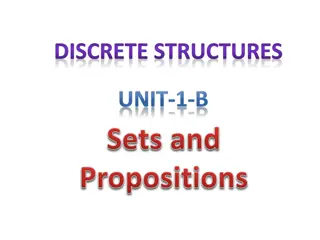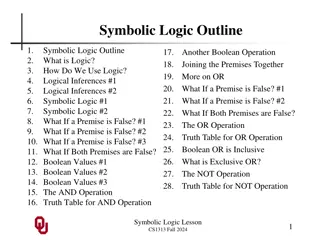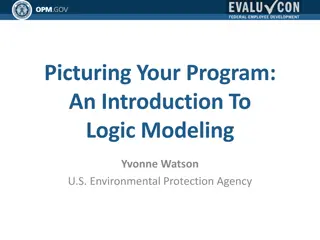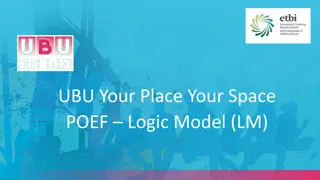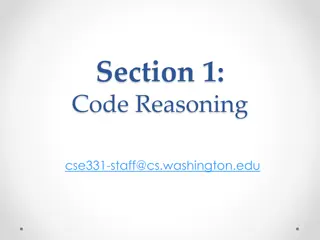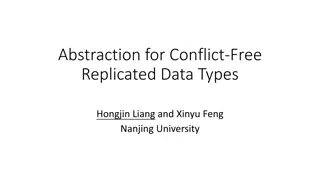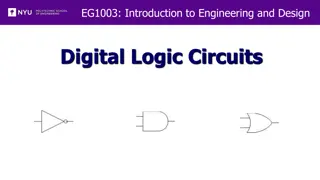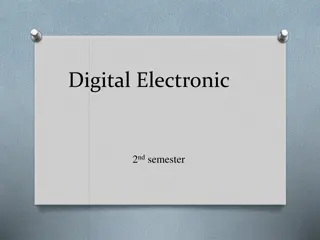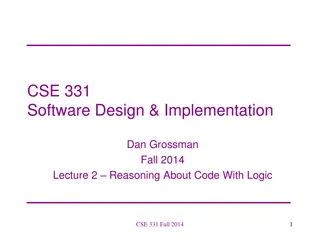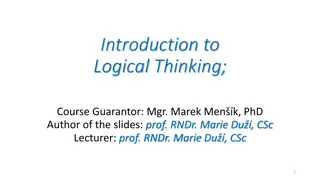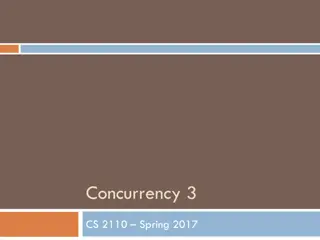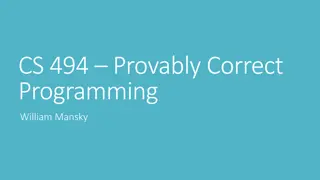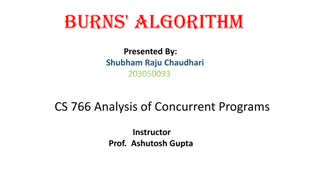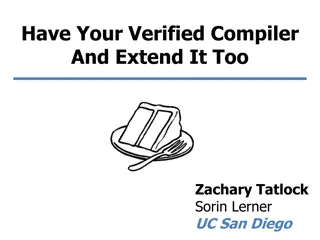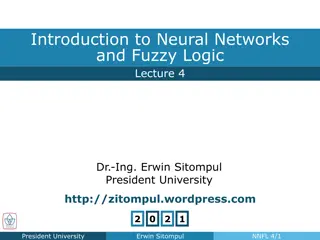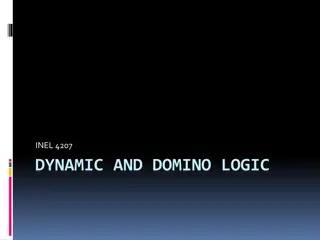Hoare Logic for Program Correctness
Hoare Logic is a powerful technique used to reason about program correctness by reducing programs to verification conditions. Learn about Hoare triples, weakest preconditions, and more in Hoare Logic to ensure program reliability. Explore how to specify relations between a program's input and output results for total and partial correctness interpretations.
Download Presentation

Please find below an Image/Link to download the presentation.
The content on the website is provided AS IS for your information and personal use only. It may not be sold, licensed, or shared on other websites without obtaining consent from the author.If you encounter any issues during the download, it is possible that the publisher has removed the file from their server.
You are allowed to download the files provided on this website for personal or commercial use, subject to the condition that they are used lawfully. All files are the property of their respective owners.
The content on the website is provided AS IS for your information and personal use only. It may not be sold, licensed, or shared on other websites without obtaining consent from the author.
E N D
Presentation Transcript
Topic 6: Customer relationship Developed by Vesela Dicheva, PhD CloudEARTHi
2. Customer Relationship Management 3. Customer Relationship Management (CRM) Systems - Functions and Classification 4. Strategies for managing customer relationships 5. Benefits of Implementing CRM Strategies CloudEARTHi
What is costumer relationship? CloudEARTHi
What is costumer relationship? CloudEARTHi
What is costumer relationship? CloudEARTHi
Customer Relationship Management The term "Customer Relationship Management" (CRM) represents a comprehensive concept and business strategy for developing and maintaining customer relationships. It is based on integrating communication channels, data processing, and coordinating the efforts of all departments within the company that are involved with customers in one way or another. CloudEARTHi
CRM concept CRM tasks: Identification of customers - storing and processing individual customer information. This includes identifying the customer and instant access to their profile when contact is made. Differentiation of customers - here the principle of the Italian economist Pareto can be applied, which states: "20% of customers account for 80% of sales Interaction with customers - here it is necessary to have information on the history of relationships with customers to track customer preferences and attempts to satisfy them through various methods of communication: websites, email, phone calls, SMS, mail. Personalization of customers - each customer is rated by the company. CloudEARTHi
Customer Relationship Management (CRM) Systems - Functions and Classification Customer Relationship Management (CRM) system represents a set of applications through which information about customers is gathered. This information is processed, stored, and exported, providing in a format convenient for making management decisions. The main functions of the CRM system are: Information gathering: This information is collected in a unified database of the company, with data inputted by either an employee of the company or the customer themselves. Processing and storing information: This is done through technologies and corresponding applications implemented by the company, which analyze the inputted data to further export the information to various levels and departments of the company. Exporting information: This is an important function that allows the use of information in different departments of the company, where employees can see what products or services can be offered to the customer based on past purchases. For regular customers, the system reminds that various discounts are available. CloudEARTHi
Customer Relationship Management (CRM) Systems - Functions and Classification CloudEARTHi
Strategies for managing customer relationships enabling more effective business decisions by company management. Process Redesign Strategy: This involves analyzing processes within and outside the company, and if necessary, redesigning business processes such as sales, delivery, and customer service. The focus here is on leveraging the advantages of new technologies such as the internet, wireless communications, and other innovations to improve competitiveness, productivity, and company revenue, while also enhancing the quality of customer service. Marketing Strategy: This CRM strategy is primarily aimed at attracting new customers and retaining existing ones using marketing methods through various channels such as TV media, websites, email, phone, SMS, and mail. Customer Service: This CRM strategy is one of the key factors in maintaining existing customers and attracting new ones. The most important aspect here is to maximize customer satisfaction by establishing "customer service points" where customers can return unsatisfactory goods, provide feedback, and make recommendations for specific products to enhance their quality. Analytical Strategy: This strategy utilizes a system of programs that analyze customer data and preferences, CloudEARTHi
Benefits of Implementing CRM Strategies: strategies and goals enables management to develop CRM strategies that increase sales and profits in the long term. This is made possible by CRM software that provides access to customer databases for their purchases and preferences, significantly facilitating employees to select and implement the right CRM strategy. Conversion of Potential Customers into Real Ones: This is achieved through CRM strategies that target a large number of potential customers by offering them favorable deals through various communication channels (internet, phone, mail). The goal is for these potential customers to be convinced of the quality of the company's products and services, thereby increasing future sales and profits for the company. Improved Customer Service: This is achieved through the use of various CRM strategies, such as customer service and feedback from customers. Customer service is often provided at designated points where users can make complaints and recommendations for certain products or services, while customer feedback is most often obtained via the internet (email), phone, or mail, where company employees ask/send questions to customers about their satisfaction with purchased products or services. This way, maximum customer satisfaction is achieved, and the quality of the products and services offered by the company is improved. Increased Revenue and Profits: Finding the right CRM software that aligns with the company's business CloudEARTHi
https://mooc.cloudearthi.com/courses/ For questions: vdicheva@tu-varna.bg CloudEARTHi
